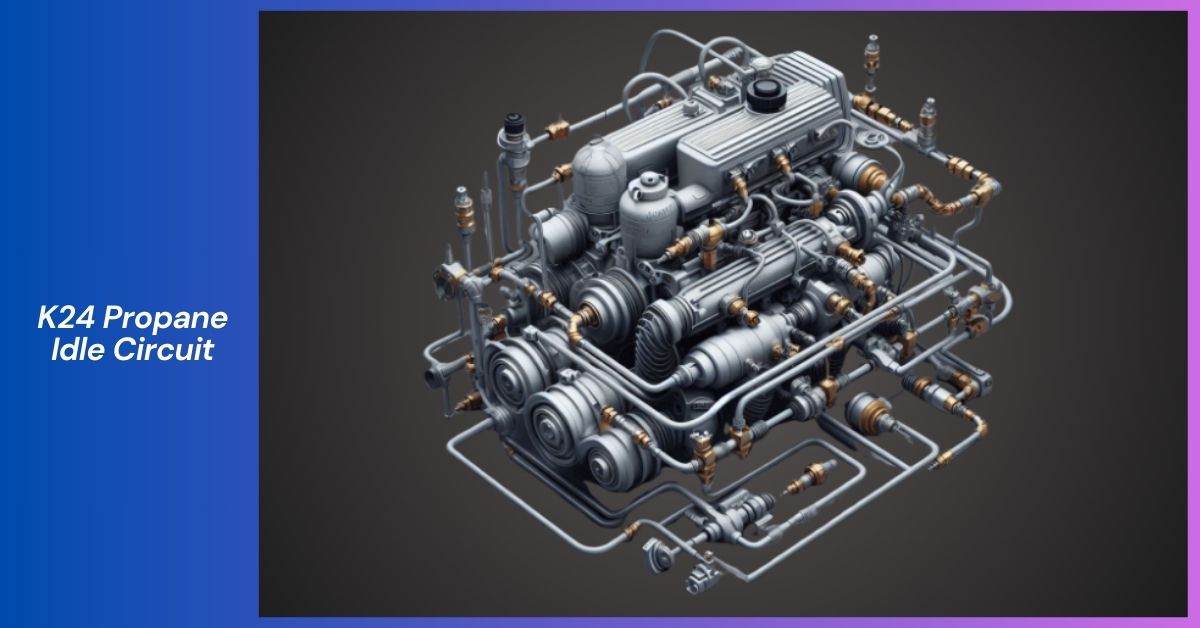
In today’s world, where energy efficiency and alternative fuel sources are becoming more essential, propane has emerged as a reliable and cleaner option for many engines.
The K24 propane idle circuit is a critical component in propane-powered vehicles and machinery.
It ensures smooth operation, especially at idle speeds, by balancing the air intake with fuel supply, preventing stalling, and maintaining engine stability.
This guide provides a detailed overview of the K24 Propane Idle Circuit, explaining its role, working mechanism, common issues, and how to maintain it for optimal performance.
Whether you’re a car enthusiast, a mechanic, or someone curious about alternative fuels, this easy-to-read article will give you all the necessary insights.
What is the K24 Propane Idle Circuit?
The K24 Propane Idle Circuit is a system within propane-fueled engines, specifically those using the K24 engine, that controls the idle speed by regulating the mixture of air and propane fuel.
The idle circuit is essential for maintaining smooth and consistent engine operation, especially when the vehicle is stationary or not under load.
In propane engines, achieving the right air-fuel ratio is crucial for efficient performance. Propane behaves differently from gasoline, so it requires more precise regulation.
The K24 propane idle circuit uses valves, sensors, and control mechanisms to continuously monitor and adjust the air-fuel mix to ensure the engine runs smoothly at low speeds without stalling or misfiring.
How Does the K24 Propane Idle Circuit Work?
The K24 propane idle circuit operates by balancing air intake with the fuel supply. It ensures that when the engine is idling, the right amount of propane enters the combustion chamber, maintaining the optimal air-fuel ratio.
Here’s a simplified breakdown of how the system works:
- Air and Fuel Mixing: The idle circuit regulates the entry of air and propane into the engine. The air comes through an intake valve, while the propane is delivered from the fuel tank.
- Sensors and Valves: The circuit relies on sensors that monitor the engine’s performance, such as throttle position sensors, air intake sensors, and fuel pressure sensors. These sensors provide real-time data to a control module, which adjusts the valves accordingly to balance the air and fuel mix.
- Regulating Idle Speed: When the engine is idling (i.e., when it’s running but the vehicle isn’t moving), the idle circuit ensures a smooth, steady supply of fuel. If too much air enters the engine, it can cause a lean mixture, leading to rough idling or stalling. Conversely, too much propane can create a rich mixture, which leads to inefficient fuel usage and increased emissions.
- Idle Control Valve: A critical component of the idle circuit is the idle air control valve (IACV), which opens or closes based on the engine’s needs, allowing more or less air to mix with the propane. This valve plays a key role in ensuring that the engine runs efficiently at low RPMs.
Importance of the K24 Propane Idle Circuit
The K24 propane idle circuit is vital for maintaining optimal engine performance, especially for propane-powered vehicles. Here’s why this system is so important:
- Engine Stability: Without a properly functioning idle circuit, the engine would struggle to maintain a consistent idle, which could result in stalling, rough idling, or even complete engine failure in extreme cases.
- Fuel Efficiency: By ensuring the correct balance of air and propane at idle speeds, the system helps optimize fuel consumption, saving money on fuel and reducing unnecessary propane usage.
- Reduced Emissions: Propane is already a cleaner-burning fuel compared to gasoline. However, a finely tuned idle circuit ensures that the engine burns propane efficiently, leading to fewer emissions and a reduced environmental impact.
- Preventing Engine Damage: A malfunctioning idle circuit can result in misfiring or backfiring, potentially causing damage to engine components over time. A well-maintained K24 propane idle circuit helps avoid these issues.
Common Problems with the K24 Propane Idle Circuit
Like any mechanical system, the K24 propane idle circuit can experience issues that affect engine performance.
Understanding these common problems can help in troubleshooting and maintenance:
1. Rough Idling
If the engine idles roughly or inconsistently, it could be a sign of a problem with the idle circuit.
This could be due to a faulty idle air control valve (IACV) or a sensor providing incorrect data.
2. Stalling at Idle
One of the most common issues is the engine stalling when idling.
This can happen when there’s too much or too little air in the mix, causing the engine to choke or flood with propane.
3. Lean or Rich Air-Fuel Mixture
The idle circuit needs to maintain a precise balance between air and propane. If there’s too much air, the engine runs lean, causing rough idling or hesitation.
Too much fuel results in a rich mixture, leading to poor fuel economy and increased emissions.
4. Failed Sensors
Sensors in the K24 propane idle circuit play a key role in monitoring engine performance and adjusting the air-fuel mix.
If one of these sensors fails, it can cause erratic idling or prevent the engine from running efficiently at idle.
5. Clogged Valves
Over time, valves in the idle circuit can become clogged with debris or carbon buildup, restricting airflow and preventing proper fuel regulation.
Cleaning or replacing these valves is crucial to maintaining smooth operation.
How to Maintain the K24 Propane Idle Circuit
Maintaining the K24 propane idle circuit is essential for ensuring long-term engine performance and efficiency.
Here are some maintenance tips to keep the system running smoothly:
1. Regular Cleaning
The idle air control valve (IACV) and other components can accumulate dirt and carbon buildup over time, leading to blockages.
Regular cleaning of these parts can help prevent rough idling and ensure smooth engine operation.
2. Check for Sensor Malfunctions
Faulty sensors can cause a variety of issues, from rough idling to stalling. Regularly check the sensors connected to the idle circuit, such as throttle position and air intake sensors, to ensure they’re working correctly.
3. Inspect and Replace Valves
The valves that regulate the air-fuel mixture can wear out or get clogged. It’s important to inspect these components regularly and replace them when necessary to prevent idle issues.
4. Adjust Air-Fuel Mixture
If you’re noticing rough idling or stalling, the air-fuel mixture may need adjusting. A mechanic with experience in propane engines can fine-tune the idle circuit to ensure the correct balance.
5. Monitor Fuel Pressure
Keeping an eye on propane fuel pressure is also crucial. Inconsistent pressure can cause issues with fuel delivery, leading to idle circuit problems.
Why Choose Propane Engines with K24 Propane Idle Circuit?
The K24 propane idle circuit is a key feature in many propane-fueled engines, and it offers several advantages:
- Eco-Friendly: Propane is a cleaner alternative to gasoline or diesel, producing fewer emissions. The idle circuit ensures optimal fuel efficiency, further reducing the environmental impact.
- Cost-Effective: Propane is often cheaper than gasoline, and the K24 propane idle circuit helps maximize fuel efficiency, saving money in the long run.
- Reduced Maintenance Costs: Engines with propane idle circuits generally require less maintenance compared to gasoline engines, as they burn cleaner and produce less carbon buildup.
FAQs About the K24 Propane Idle Circuit
What causes my engine to stall when idling?
Stalling at idle could be due to a variety of reasons, including a faulty idle air control valve, sensor failure, or an improper air-fuel mixture. Checking the sensors and valves in the idle circuit is the first step in diagnosing the issue.
How often should I clean the idle circuit components?
It’s recommended to inspect and clean idle circuit components, like the idle air control valve, at least once a year, especially if you drive in dusty environments. More frequent checks may be necessary depending on usage.
Can I adjust the idle speed myself?
While some adjustments to the idle speed can be made manually, it’s best to consult a mechanic with experience in propane engines to ensure the settings are correct. Improper adjustments can lead to engine damage or poor performance.
What are the signs of a failing idle air control valve (IACV)?
A failing IACV can cause rough idling, stalling, or an inability to maintain a steady idle speed. If you notice these symptoms, it may be time to replace or clean the valve.
Is propane better than gasoline for engines?
Propane offers several benefits over gasoline, including cleaner combustion, lower emissions, and potentially lower fuel costs. However, it requires specialized systems like the K24 propane idle circuit to operate efficiently.
Conclusion
The K24 propane idle circuit is a vital component in propane-powered engines, ensuring smooth and efficient operation at idle speeds.
By balancing the air-fuel mixture and using advanced sensors and valves, the system helps optimize fuel consumption, reduce emissions, and prevent engine stalling.
Regular maintenance and understanding of the system can help prevent common issues, ensuring long-lasting engine performance.
For anyone using propane-powered vehicles or equipment, investing in the proper care of the K24 propane idle circuit is key to getting the most out of your engine.
By understanding and maintaining this system, you can enjoy the benefits of propane as a cleaner, cost-effective alternative to traditional fuels.





